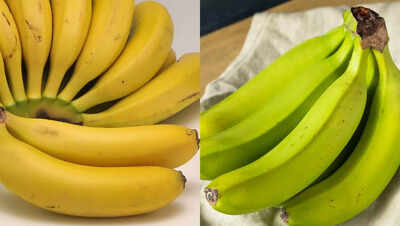Ripe vs. Unripe Bananas: Which works better for blood sugar control, weight loss, and digestion |

Bananas are among the world’s most popular fruits, naturally sweet, easy to digest, and full of essential nutrients. However, their health benefits shift as they ripen. The difference between a firm green banana and a soft yellow one goes beyond flavour; it can influence your digestion, blood sugar levels, and energy release. As bananas ripen, their starch gradually turns into simple sugars, altering their nutritional value and how your body processes them. Understanding these changes can help you pick the right banana for your goals, whether you want to support gut health, maintain stable blood sugar, boost energy, or simply enjoy a healthy, satisfying snack.
Ripe and unripe bananas: How ripeness impacts your health and energy levels
Bananas undergo remarkable changes as they ripen, transforming not just in taste and texture but also in their nutritional profile. When unripe, bananas are firm, less sweet, and rich in resistant starch, a type of carbohydrate that digests slowly and helps maintain steady blood sugar levels. As the fruit ripens, this starch gradually breaks down into simple sugars like glucose, fructose, and sucrose, making ripe bananas softer, sweeter, and easier to digest. The glycaemic index (GI) also rises, meaning the energy is released more quickly. Interestingly, antioxidant levels increase as bananas become overripe, enhancing their protective health benefits. In short, unripe bananas support steady energy, while ripe ones offer a quick, natural boost.
Difference between green and yellow bananas
Digestibility: Which is easier on the stomach
Unripe bananas contain resistant starch that acts like fibre, good for gut bacteria but harder for the body to digest. Some people may experience mild bloating or discomfort if their gut isn’t used to it.Ripe bananas, on the other hand, are gentler on digestion. They’re ideal for people recovering from illness, children, or those with sensitive stomachs.If you have conditions like IBS or acid reflux, ripe bananas may be better tolerated.
Blood sugar response and energy levels
One of the biggest differences between ripe and unripe bananas lies in how they affect your blood sugar.Green bananas have a lower glycaemic index (GI), meaning they release energy slowly. This helps maintain steady blood sugar levels and prolonged satiety.Ripe bananas have a higher GI, offering quick energy but potentially leading to a short-lived sugar spike.According to a study published in the Journal of Food Science and Technology, the glycaemic index of bananas increases as they ripen because the resistant starch in green bananas converts into simple sugars like glucose and fructose. This transformation significantly affects how the body absorbs and utilises energy from the fruit.Best for:
- Unripe bananas: People with diabetes or insulin sensitivity
- Ripe bananas: Athletes, children, or anyone needing fast energy before a workout
Fibre and resistant starch
Unripe bananas are packed with resistant starch, a unique form of carbohydrate that “resists” digestion and behaves like fibre. It feeds healthy gut bacteria, supporting digestion and bowel health.As bananas ripen, resistant starch turns into natural sugars, reducing fibre content but improving digestibility.
Which type supports weight loss
Unripe bananas: Higher in resistant starch, promoting fullness and reducing hunger cravings.Ripe bananas: Easier to digest and more satisfying, but may lead to higher calorie intake if overconsumed.If you’re focusing on weight control, unripe or lightly ripe bananas may keep you fuller for longer.
Antioxidants and nutrient retention
Interestingly, as bananas ripen, their antioxidant levels increase. The brown spots you see on a very ripe banana are a sign of higher phenolic compounds, beneficial plant antioxidants that help fight inflammation and oxidative stress.However, extremely overripe bananas may lose some vitamin C content, which is sensitive to heat and oxygen exposure.Best balance: Yellow bananas with small brown spots, rich in antioxidants but still nutritionally stable.
Practical tips for storing and using bananas
- To slow ripening: Separate bananas and wrap stems with cling film. Store in a cool, dark place.
- To speed ripening: Place bananas in a paper bag with an apple or pear, both release ethylene gas.
- To use overripe bananas: Blend into smoothies, bake banana bread, or make frozen desserts.
- To enjoy green bananas: Boil, steam, or lightly fry for a savoury snack or side dish.
Which banana is better: Ripe or unripe
Both ripe and unripe bananas have valuable health benefits; it’s all about what your body needs.
- Unripe bananas are excellent for gut health, blood sugar stability, and sustained energy.
- Ripe bananas are ideal for quick energy, easier digestion, and antioxidant support.
For a balanced diet, include both stages of ripeness, unripe bananas in savoury dishes or breakfast bowls, and ripe ones as a quick, natural snack.So whether you prefer a firm green banana or a sweet yellow one, both offer powerful nutrition in their own unique way.Disclaimer: This article is for informational purposes only and should not be considered medical advice. Please consult a healthcare professional before making any changes to your diet, medication, or lifestyle.Also read | Renal failure or kidney failure: Are they the same? Know the meaning, symptoms, and causes





